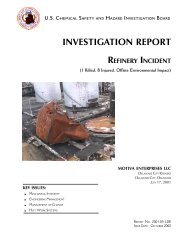CTA Report, Draft 1, ISP Review - US Chemical Safety and Hazard ...
CTA Report, Draft 1, ISP Review - US Chemical Safety and Hazard ...
CTA Report, Draft 1, ISP Review - US Chemical Safety and Hazard ...
Create successful ePaper yourself
Turn your PDF publications into a flip-book with our unique Google optimized e-Paper software.
Material Corona<br />
Charge<br />
Voltage<br />
(kV)<br />
RoRo93<br />
Table B-1<br />
Propagating Brush Discharge Test Results<br />
Charge<br />
Duration<br />
(sec)<br />
ES Field<br />
Strength<br />
Before<br />
Discharge<br />
(kV/in.)<br />
ES Field<br />
Strength<br />
After<br />
Discharge<br />
(KV/in.)<br />
Observations of Propagating Brush<br />
Discharge<br />
30 60 -30 -4 Ignition of dust, resulting in open flame<br />
Reference 30 60 -26 -6 Ignition of dust, resulting in open flame<br />
SD-52SS<br />
Sample 1<br />
SD-52SS<br />
30 60 -30 -10 No ignition of dust<br />
35 60 -28 -10 No ignition of dust<br />
40 60 -26 -10 No ignition of dust<br />
45 60 >-40 -10 No ignition of dust<br />
35 60 -26 -10 No ignition of dust<br />
Sample 2 40 60 -26 -10 No ignition of dust<br />
B.5 Hot Surface Ignition Temperature of Dust Layer<br />
This test determines the hot surface ignition temperature, which is the minimum temperature at which a<br />
dust layer will self-heat. The test was conducted per ASTM E2021-00, St<strong>and</strong>ard Test Method for Hot<br />
Surface Ignition Temperature of Dust Layers (2000a).<br />
No hot surface ignition temperature for the Durite SD-52SS material was observed up to 390°C, the<br />
maximum temperature used for this test method (Table B-2). Although the layer temperature did not<br />
exceed the hot-plate temperature in either of the two tests, the material did melt <strong>and</strong> exp<strong>and</strong> in volume.<br />
The heated powder layer liberated some fumes; however, they failed to ignite when exposed to a match<br />
flame.<br />
Therefore, according to the criteria of ASTM E2021-00, the powder layer does not ignite, though it<br />
definitely undergoes some form of reaction under heating.<br />
109









